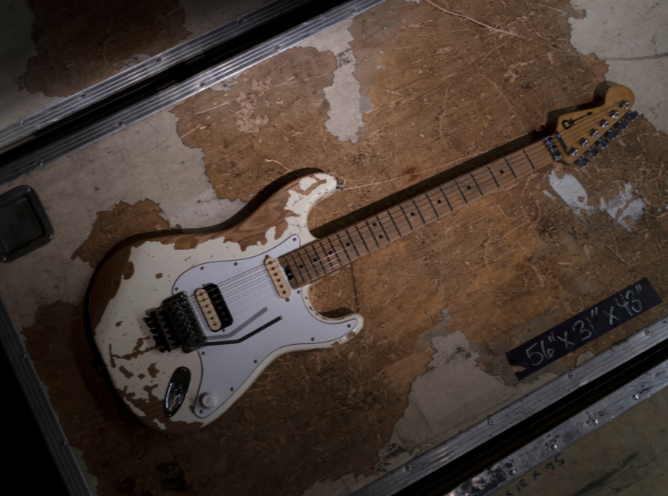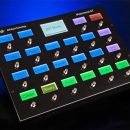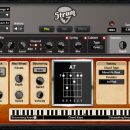 “Squish,” “Sustain,” and “Percussive Attack” are features we all take into account when trying to find that perfect classic compressor sound. As with all pedals on the market today, options are seemingly endless, and it’s sometimes quite hard to make a selection without having that hands-on live test.
“Squish,” “Sustain,” and “Percussive Attack” are features we all take into account when trying to find that perfect classic compressor sound. As with all pedals on the market today, options are seemingly endless, and it’s sometimes quite hard to make a selection without having that hands-on live test.
TC Electronic introduced a full line of Classic Series pedals to bring back their famous classic sound by reissuing some of their most prized pedals from the Seventies. Though we haven’t tested the full line of Classic Series pedals, the Classic Sustain + Parametric EQ pedal lives up to the expectation and provides a very desirable compression effect while giving us the option to dial in other tonal aspects relating to EQ.
| Category | Value | Rating |
| Features | 20% | |
| Usability | 25% | |
| Sound | 25% | |
| Documentation & Support | 10% | |
| Price | 20% | |
| OVERALL RATING = 3.6, which earns it a WIHO Award. 3.6 stars or better: Outstanding, WIHO Award 3 stars or better: Worth considering 2 stars or better: Suited to specific needs 1 star or less: Not recommended |
||
When looking for a studio quality effect in a pedal, one determining factor is how clean the signal being produced is. We found this pedal to be extremely clean, partially due to the Noise Gate feature within the unit (and of course partially due to good engineering). Though the Noise Gate feature of this pedal produced some concerns, we found that overall, the TC Electronic Classic Sustain + Parametric EQ did a very good job producing the classic “squish” and percussive attack we’ve been looking for in a pedal.
Features
The TC Electronic Classic Sustain + Parametric EQ (CSPQ) pedal provides most of the control features one would expect from a compressor pedal plus the addition of some extra useful features.
The pedal is slightly larger than most standard stomp boxes measuring approximately 4”L x 4.5”W x 1.5”H. All connection points including the ¼ inch input/output jacks and the AC power supply connection are located on the back edge of the unit. Unlike the TC Electronic Stereo Chorus Flanger pedal, the CSPQ pedal is not hard wired and accepts a standard cannon style power plug as well as 9V battery supply. We tested the unit using a Voodoo Labs Pedal Power Plus which worked perfectly with the unit.
The hinged Battery access door required a fine flat head screwdriver to open the compartment. We were not able to get our finger nail in the slot to get the door to release. However, a flat guitar pick worked just as well as a screwdriver.
Basically, there are six individual controls giving the user the ability to control four separate functions provided on the TC Electronic Classic Sustain + Parametric EQ pedal: Sustain, Output, EQ and Noise Gate.
The Sustain and Output control knobs do exactly as they are labeled. Sustain will set the amount of time you want a note to ring out and the Output control knob will provide the amount of gain level you would like the unit to produce.
The Freq center, Function control, and High-Q control knobs work together in the Parametric EQ section of the unit.
Starting with the High-Q control button, this switch allows you to control the “Q” value in relation to 2 different frequency curve width. With the “Q” button in the out position, the unit allows you to use the notch filter (Function control) to attenuate a specific frequency – basically, it gives you a narrow curve width to enable you to dial in a specific frequency for adjustment. You can either notch out or increase the peak of the frequency to your liking. With the “Q” button in the in position, it allows the user to identify a general frequency spread – a wider curve width of frequencies within a particular area.
The Freq center control knob is a parametric EQ allowing the user to dial into specific frequencies or area of frequencies for adjustment.
The Function control knob allows the user to either increase (peak) a selected frequency or decrease (notch) a selected frequency.
The Noise Gate knob controls elimination of unwanted noise produced by pedals that are placed before the TC Electronic pedal and/or by the Classic Sustain + Parametric EQ pedal itself (the gate is post-compression in the signal path). The noise gate itself was a pretty simple affair – the control knob only provided control over the Threshold point for gate response.
A bright blue LED to indicate activation status is included on the face of the unit.
All control functions are clearly labeled and easy to read due to the dark grey color of the pedal and white lettering for all markings/settings.
Last, but not forgotten, the On/Off control for this unit is a standard Carling-style metal foot switch.
Usability
The TC Electronic Classic Sustain + Parametric EQ is extremely intuitive and easy to operate. Laid out in a very accessible manner, the control knobs are of basic radio style and are clearly marked using a white indicator line on the control to mark the position of the knob. In addition, control names are labeled in white lettering over the dark grey metal housing of the unit for easy identification.
The flexibility in output and sustain gave us the ability to obtain settings for that tight country picking style to a soft spongy compression for those funky rhythm comps and never ending sustain during those soaring lead lines. This pedal provided excellent sound enhancement despite starting with high quality sounding instruments to start with.
Sound
We found the TC Electronic Classic Sustain + Parametric EQ pedal to perform extremely well, giving us the ability to adjust not only sustain and output levels, but a wide spectrum of EQ options along with the ability to gate any unwanted noise. We were truly able to achieve a studio quality “squish” that is so desired (and hard to accomplish) when looking for a compression pedal.
We tested the TC Electronic Classic Sustain + Parametric EQ pedal placed between a Mesa/Boogie Lone Star amplifier, a Gibson Les Paul Standard, and a Fender Stratocaster Eric Johnson model.
In both guitar applications, the Classic Sustain + Parametric EQ pedal functioned beautifully! The Sustain provided endless amounts of hang time while maintaining a consistent signal level as it eventually tapered off. In our experience with other compression pedals, you could hear additional hiss and noise as the sound level tapered off. Not so with the TC Electronic pedal – the sound remained crystal clear throughout its operating function.
The Output Level control allowed proper adjustment as needed depending on the output of the guitar and the settings of the Sustain and Noise Gate controls, which also had an effect on output level.
Despite simplified functionality compared to studio noise gates, we found the Noise Gate feature on the pedal to be extremely effective. As stated above, the pedal was extremely crystal clear, and when using the Stratocaster, we were able to eliminate any hiss or hum produced by the single coil pickup configuration by increasing the Threshold of the gate.
We did struggle with some other aspects of the Noise Gate function on the pedal, though. The noise gate lacks user control over Attack and Release parameters – it has fixed settings internally which are based on common applications. This resulted in an obvious loss of attack at some settings. With the gate set at full Open threshold (clockwise), the attack and operation of the gate functioned fine. As we backed off on the control knob increasing the threshold, the noise gate did cancel out any unwanted noise, but there were three noticeable concerns that we observed:
1) Between the 2:00 and 3:00 position, there was a huge difference in the function of the noise gate, most noticeably in gain/volume levels. As the threshold was increased, the volume level of the signal decreased. As a result, when placed in a pedal chain preceding a distortion pedal, we experienced loss of drive as well as decreased volume levels.
2) As we rolled the Noise Gate counter-clockwise from the full 5:00 position, the gate did not open quickly enough for our personal preference. This caused a continuous fade-in effect, especially noticeable on initial chord comping or any time the gate was able to close completely due to absence of signal.
3) We would have liked to have been able to disengage the Noise Gate function of the pedal – there is not an off switch for this function other than setting the Threshold to its most minimal point. The loss of attack in some settings was undesirable which forced us to keep the Noise Gate in the most open position.
The Parametric EQ section provided extensive options for selection of specific frequency/tone modifications. The High-Q button used to determine a wide or narrow frequency range in conjunction with the Freq Center control allowed us to dial in specific frequencies for filtering by Notching or Peaking the selected frequency. With the Function control set clockwise to the full Peak position and sweeping the Freq Center control in both directions, we were able to hear the full spectrum of frequency options for adjustment. The possibilities were endless.
Documentation and Product Support
TC Electronic provided basic documentation regarding connections and control functionality to get the user acquainted with the Classic Sustain + Parametric EQ pedal. Their web site also provides much of the same information as well as an extensive online support. One feature we particularly like to see from pedal manufacturers, though, that TC Electronic did not include in the pedal documentation, is some sample settings to get started.
We find it useful to have a suggested reference point before making incremental changes to reach a desired effect. What TC Electronic did provide via their website was a demo of the Classic Sustain + Parametric EQ, from which we were able to view and mirror their initial settings for a starting point of reference.
Price
The TC Electronic Classic Sustain + Parametric EQ (MSRP $395) can be found online for approximately $299. We feel that although the TC Electronic pedal provides strong functionality and excellent sound quality (particularly for the Compressor and EQ), the price is a little bit steep.
Contact Information
TC Electronic
www.tcelectronic.com
| Evaluation Short-List |
|

















